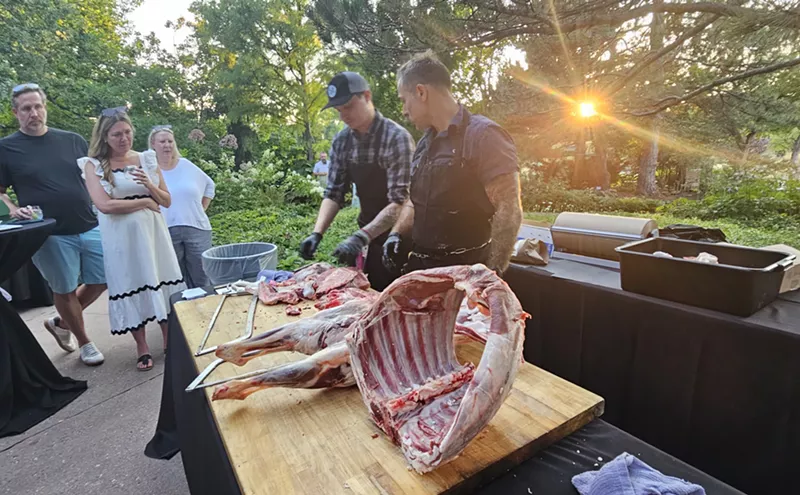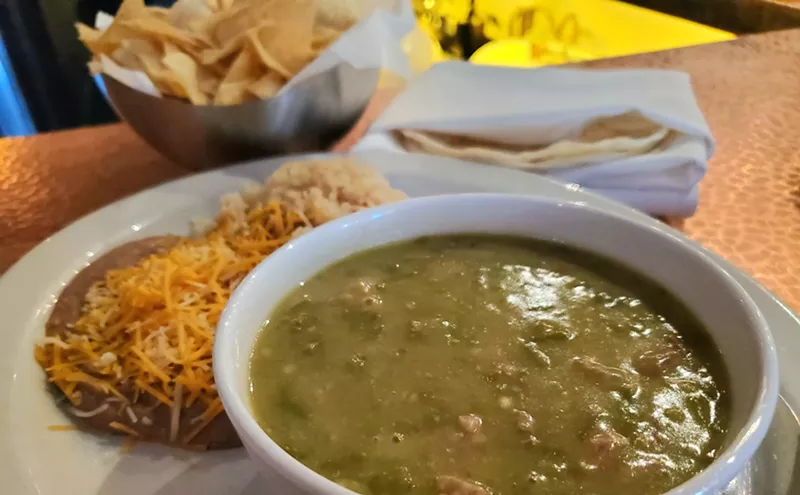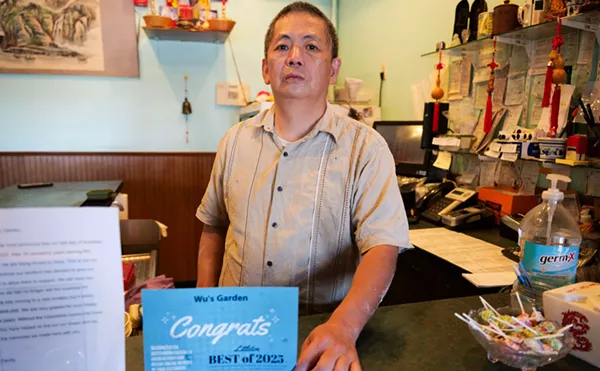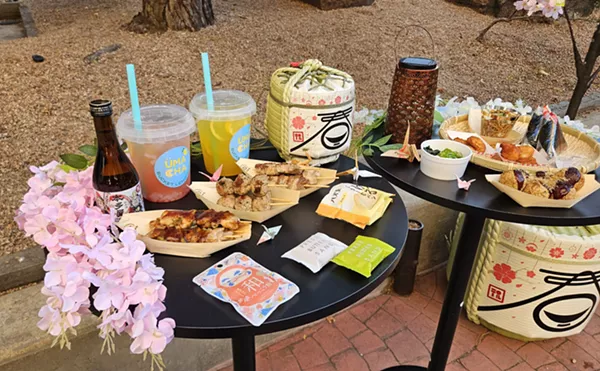If I were Scheherazade spinning tales to save my life before a disgruntled king, I'd look to Work & Class for inspiration. Within the confines of this much-anticipated Ballpark restaurant, which opened at full tilt four months ago and hasn't looked back since, there are stories to last a thousand and one nights, maybe even a thousand and two.
See also: A Closer Look at Work & Class
My first story, the one I'd tell to pique the king's interest so I wouldn't suffer the fate of previous brides, would be about underdogs, because nothing gets people to the edge of their seats like rooting for the little guy. Delores Tronco, owner-buckstopper, as she jokingly calls herself, left a job in communications to take a risk in the food industry. Tony Maciag, owner-general manager, hails from Detroit, an underdog with a capital "U." Dana Rodriguez, owner-executive chef, grew up on a farm in Mexico without running water or electricity, moved to the United States with three young daughters, and worked her way up from dishwasher at Panzano to chef de cuisine at Bistro Vendôme. These backgrounds inspired the restaurant's name -- say it quickly and you'll hear "working class" -- and its concept, pitched by Tronco to investors as "a square meal, a stiff drink and a fair price."My next story would be about celebrities, because everyone likes to hear that kind, even kings. Besides, without one of our favorite culinary rock stars, aka James Beard award winner Jennifer Jasinski, there might not have been a story to tell. Tronco and Maciag overlapped at one of Jasinski's restaurants, and Jasinski herself took Rodriguez under her wing. "One day Jen told me I was ready to be sous-chef, but I said no because my English was not good," recalls Rodriguez. "She said, 'Oh, no, you're ready,' but I said no two times. The third time, I said, 'Okay, fine.'"
But no matter how suspenseful these stories may be, the one that matters most -- for a restaurant review, at least -- is about what it's like to eat there. So it's a good thing I'm not Scheherazade, and that my life doesn't depend on a cliffhanger. Given the lines snaking out the door, there's little mystery how this story will end: Work & Class is a restaurant that works, doing what it set out to do not just well, but brilliantly.And diners quickly recognized this, as is evident if you've tried to get a table at 7 p.m. on a Friday and been told to come back in an hour -- or two. But it's just as evident if you arrive earlier in the day and earlier in the week, as I did on my first visit, when the place was so packed that I wished the hostess had passed out noise-canceling headphones along with our menus. Work & Class is loud -- and not just because every square inch of the place is usually filled with people tucking into an eclectic mix of American and Latin American fare, but because it's full of hard surfaces that catapult, not absorb, the sound. The restaurant was made out of shipping containers, and that gritty, industrial feel is echoed within. Walls feature corrugated and powdered steel, brushed concrete and a photograph of an abandoned auto plant. The community table in the center of the narrow dining room, the one you'll squeeze past to get to the patio or chef's counter, is fashioned from a conveyor belt set into that great noise-absorber (ha, ha), concrete.
But the hostess didn't give us headphones, and the server didn't carry a microphone, so we shouted our order, then dumbly nodded and smiled as she said something in return. Exactly what, we didn't learn until later, after a trio of appetizers arrived. Green chili beans, a flourless recipe Rodriguez perfected for family meal at Rioja, got the burn going, with an electric purée of Anaheims, jalapeños, poblanos and tomatillos studded with beans. Gluten-free meatballs over polenta -- one of many gluten-free items on the menu -- boasted an unexpected but delightful kick, thanks to a chipotle-spiked tomato sauce. But it was our first bite of panko-coated Fresno poppers that filled in those missing blanks. "The Fresnos are running hotter than normal this week," our server said when we waved her over for more water. "I'm sorry; I thought I told you before."
Keep reading for the rest of our review of Work & Class.
She had, of course, but we'd missed it. What she hadn't said, though, was that those peppers, plated with bacon-wrapped jalapeños, grilled shishitos, pickled peppers and pepper jam, constituted the backbone of one of the most stylish plates on the menu, a welcome peek at the kitchen's sophisticated training.Kitchens tend to strut their stuff with entrees, showing off touch-intensive presentations, tweezer-assisted plating and the like. At Work & Class, however, entrees are humble, a handful of roasted and braised proteins offered by the quarter-, half- and full pound, unassumingly heaped in a pie tin. And that initially made Rodriguez nervous. "I was worried that people might think it was like a diner or buffet," she recalls. "When they see a beautiful plate, they know how hard you worked on it, but when they see a simple plate, they might think you did less steps."
Slices of tender roasted Colorado lamb, scented with coriander, cumin and garlic, proved that no steps were skipped. So did rotisserie chicken, brined and then twirled on a spit for a moist interior and crisp skin, and cochinita pibil, a Yucatán specialty from sous-chef Vicente Sosa, Rodriguez's fiancé and fellow Rioja alum. Rubbed with achiote paste, covered with banana leaves and slow-braised, the shredded, orange-tinted pork was the one protein we wished we'd upsized; the scant leftovers we did have tasted even better the next day. Orange and lime juices accented the rub, but the real brightness came from the accompanying cilantro-lime slaw, which we spread over ad hoc tacos fashioned from housemade corn tortillas that the kitchen likes to send out gratis.Cabrito, a traditional Jaliscan dish of roasted goat rubbed with guajillo chiles, arrived like a man in a tux and cowboy boots, a homestyle offering with a four-star side of consommé to sip between bites. (If you're skeptical about goat, there are no worries here: Between the consommé and the chiles, the goat never had the barnyard taste that can turn people off.)
Despite the Mexican flair, not all food is Latin in origin. Flaky biscuits, cornmeal-crusted catfish and creamy braised greens, so lightly creamed the grassiness still came through, provided a Southern touch. Meatballs and polenta spoke to Tronco's Italian roots, though the latter had a tendency to dry out when ordered as a side. And even if you've stayed south of the border for your appetizers and entrees, no meal should end without an order of deeply caramelized butterscotch pudding sprinkled with almond toffee.If I were Scheherazade, I would definitely relay Tronco's story of the "aha moment" she experienced as a teen waiting tables. One day an elderly couple, regulars, asked for a larger table. Family would be joining them -- not for a birthday, but to celebrate a milestone in the woman's chemotherapy. "This isn't just dinner for them," realized Tronco, and this epiphany influenced the way she approaches Work & Class: "People say, 'I'm just a waitress, just a line cook, just a bartender'...[but] it's not a 'just.' It is important."
I had an aha moment of my own -- less lofty, but noteworthy all the same -- one night when I rearranged the numerous pie tins on our table so that I could stick my fork into the short rib. In keeping with the kitchen's simplistic plating, the rib didn't look like much. The sides that other kitchens would use to decorate the plate were sitting in their own tins: Mexican corn on the cob; chorizo, lentil and plantain hash; chickpea fries so pudding-like and creamy, it's a wonder they withstood the fryer. The rib looked lonesome, but it had everything I wanted from that cut of meat -- it was well trimmed, full of flavor from its stout braise, and it broke apart into tender strands. It had something else, too: a shockingly low price. At $6.75 for a quarter-pound, the rib -- roughly the same portion as entrees elsewhere -- cost a fraction of the usual tab. Aha: Not only does Work & Class offer a square meal, but it does so at a more-than-fair price.
Which brings this story back to that pepper appetizer. It isn't just one of the most stylishly plated items on the menu; it's quite possibly the most expensive you'll order all night, assuming you follow the prevailing strategy and order an assortment of quarter-pound meats so that you can sample as many as possible. And by most expensive, I mean $12. With bargains like that, I can't be the only one saying "aha" -- or, if you're a competitor, "Oh, hell."
So maybe there is a cliffhanger to the story of Work & Class. In less time than it's taken for the snow to melt off the slopes, Work & Class has proven itself to be a game-changer, serving fine-dining fare at casual prices in a mix-and-match format that trumps even the flexibility of small plates. What restaurateurs do in response should definitely be good enough to buy Scheherazade another night.
Select menu items at Work & Class:Work & Class is open from 4 to 10 p.m. Tuesday through Thursday, 4 to 11 p.m. Friday and Saturday, and 4 to 10 p.m. Sunday. Contact the restaurant at workandclassdenver.com.Green chili beans $6
Meatballs $9
Peppers Five Ways $12
Coriander-roasted lamb, 1/4 pound $6.75
Cochinita pibil, 1/4 pound $6.75
Cabrito, 1/4 pound $6.75
Stout-braised short ribs, 1/4 pound $6.75
Creamy braised greens $5
Chickpea croquettes $5
Butterscotch pudding $3/6
Follow @CafeWestword











